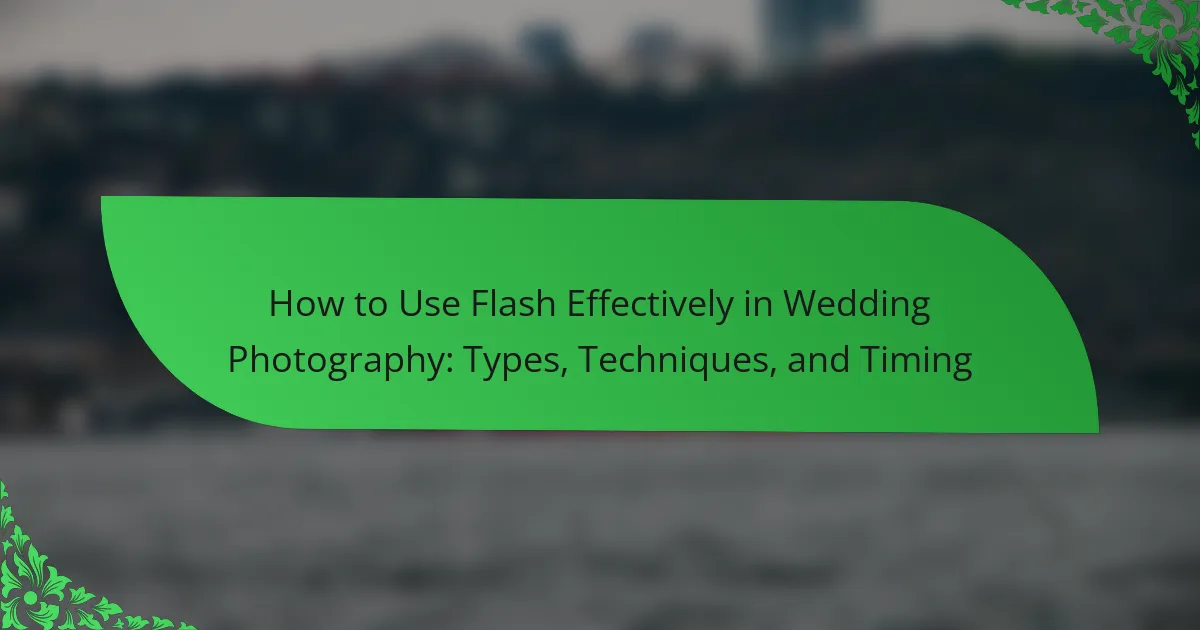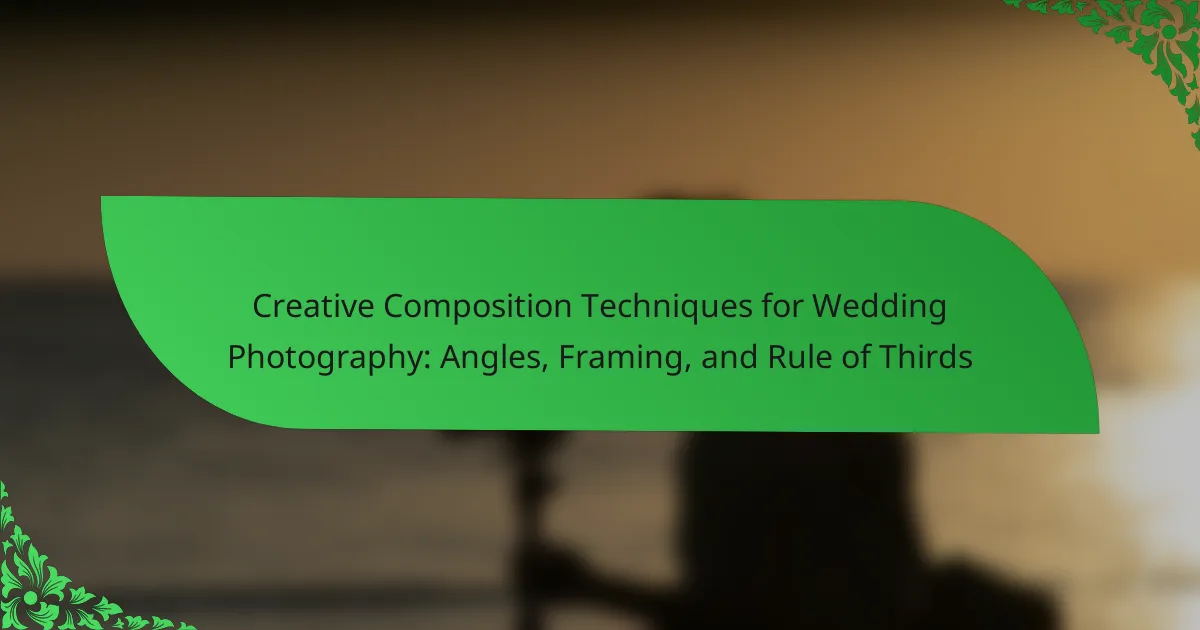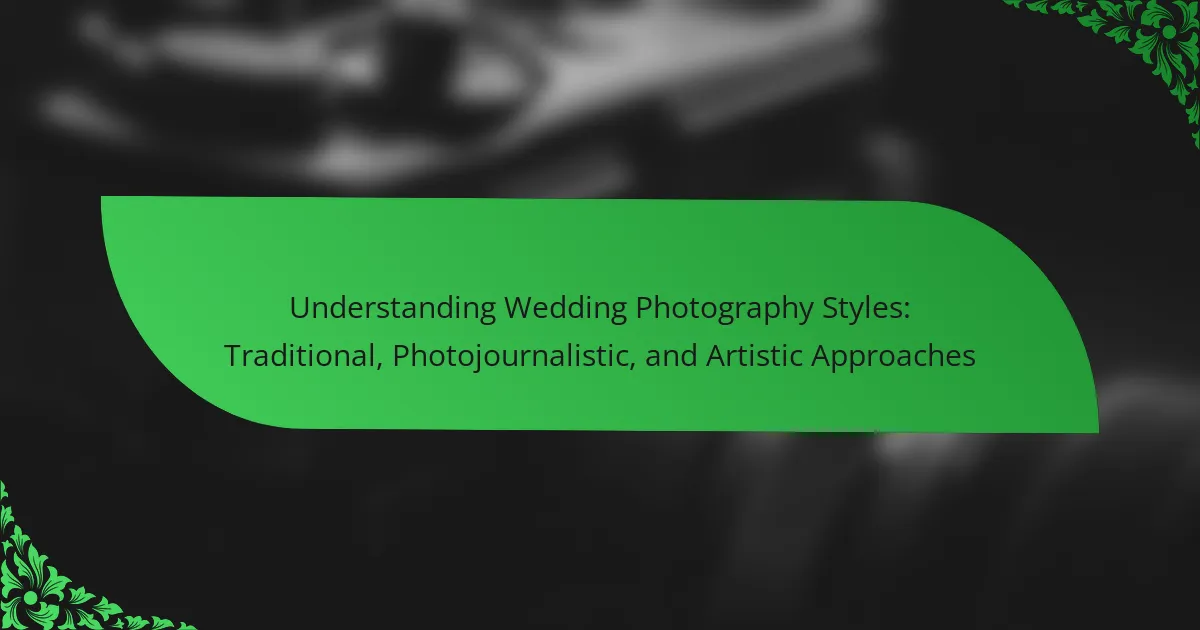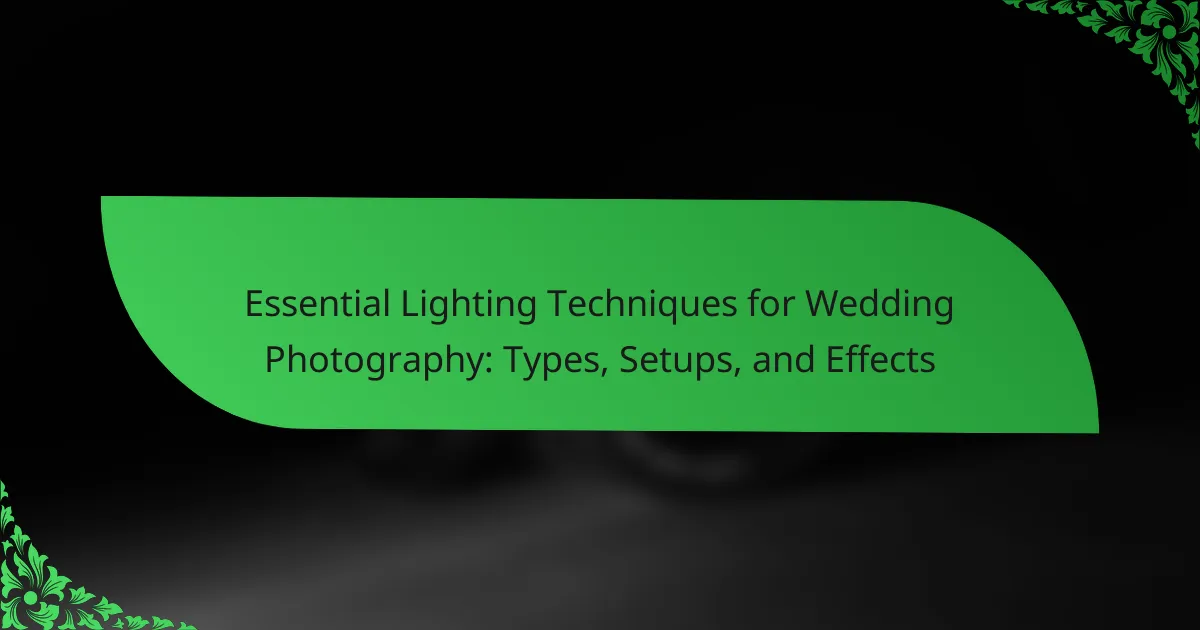Flash is a crucial tool in wedding photography, enhancing image quality by providing additional light in low-light conditions. It illuminates subjects, creates catchlights for depth in portraits, and freezes motion for sharp images of dynamic moments. The article covers effective techniques for using flash, including adjusting power settings, using diffusers to soften light, and ensuring proper synchronization with camera settings. It also highlights the importance of assessing lighting conditions, considering subjects’ comfort with flash, and communicating with couples about their preferences. Additionally, it emphasizes the benefits of practicing with off-camera flash to achieve creative lighting effects in various environments.
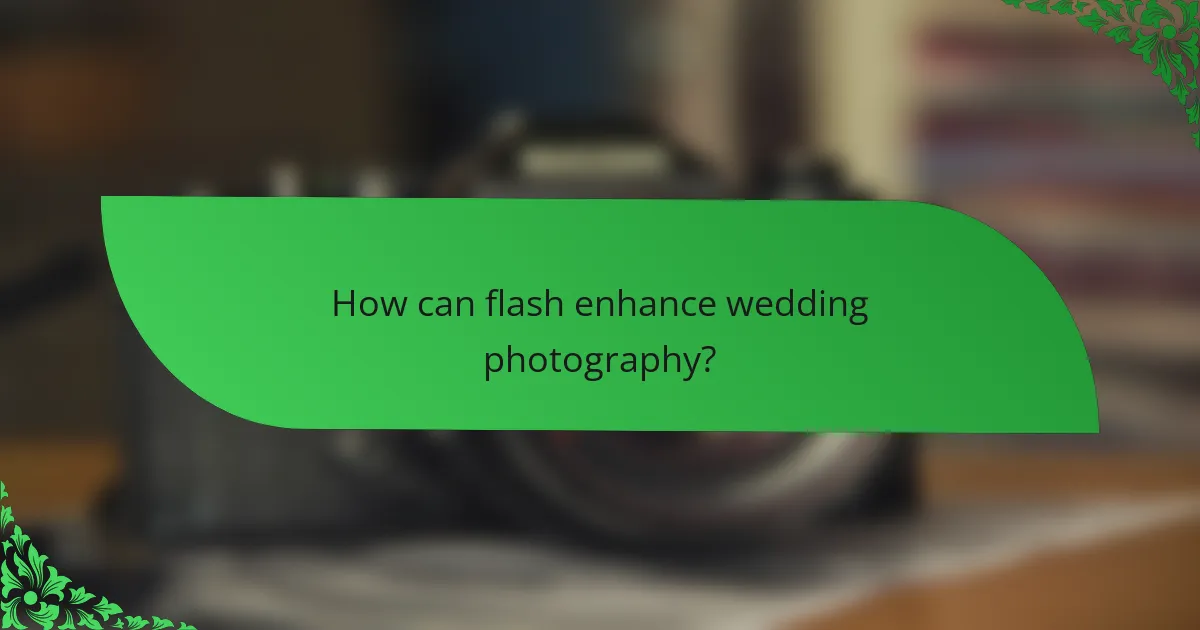
How can flash enhance wedding photography?
Flash can enhance wedding photography by providing additional light in low-light situations. It helps to illuminate subjects, ensuring they are well-lit and clear. This is particularly beneficial during evening receptions or indoor ceremonies. Flash can also create a catchlight in the eyes, adding depth and vibrancy to portraits. Furthermore, it allows for the freezing of motion, capturing sharp images of dynamic moments. The use of flash can also improve colors, making them more vivid and true to life. Additionally, flash can help to reduce harsh shadows, creating a more flattering light on subjects. Overall, flash is a versatile tool that significantly improves the quality of wedding photographs.
What are the different types of flash used in wedding photography?
The different types of flash used in wedding photography include on-camera flash, off-camera flash, and studio strobes. On-camera flash is mounted directly on the camera. It provides direct lighting and is convenient for quick shots. Off-camera flash allows for more creative lighting angles. It can be positioned away from the camera for dramatic effects. Studio strobes are powerful lights used in controlled environments. They offer high output and can be adjusted for various settings. Each type serves specific purposes in capturing quality images during weddings.
How does on-camera flash differ from off-camera flash?
On-camera flash is mounted directly on the camera, while off-camera flash is positioned away from the camera. On-camera flash provides direct lighting, often resulting in harsh shadows. Off-camera flash allows for more creative lighting angles and softer shadows. This flexibility enhances the overall composition of wedding photographs. Off-camera flash can be triggered wirelessly, enabling dynamic setups. In contrast, on-camera flash is limited to the camera’s position. Photographers often prefer off-camera flash for dramatic effects and better control over lighting. Studies show that off-camera flash techniques improve image quality in various lighting conditions.
What are the advantages of using external flash units?
External flash units provide several advantages for photographers. They offer greater power compared to built-in flash units. This increased power allows for better illumination in low-light situations. External flashes also provide more control over lighting direction. Photographers can tilt and swivel the flash head to create desired effects. Additionally, external flash units often support various lighting modifiers. This versatility enables photographers to shape and diffuse light more effectively. Moreover, they can be used off-camera for creative lighting setups. This flexibility enhances the overall quality of wedding photography.
Why is timing important when using flash in wedding photography?
Timing is crucial when using flash in wedding photography to ensure proper exposure and to capture candid moments. Flash can freeze motion, making it essential to synchronize the flash with the camera’s shutter speed. If the timing is off, the image may appear overexposed or underexposed. Proper timing helps to illuminate subjects without causing harsh shadows. Additionally, using flash at the right moment can enhance the atmosphere of the scene. For instance, firing the flash during a kiss can create a dramatic effect. Research shows that well-timed flash can improve the overall quality of wedding photos significantly.
How can flash timing affect the mood of wedding photos?
Flash timing can significantly affect the mood of wedding photos. When flash is used at the right moment, it can enhance the emotional impact of an image. For instance, firing the flash during a kiss can capture the intimacy of the moment. Conversely, if the flash is too early or too late, it may disrupt the natural expression or action. This misalignment can lead to unflattering shadows or harsh lighting. Proper timing helps create a soft, romantic atmosphere. Studies show that well-timed flash can improve the overall aesthetic of wedding photography. Photographers often adjust flash timing based on the scene and desired mood.
What are the best moments during a wedding to use flash?
The best moments during a wedding to use flash include the ceremony, first dance, and cake cutting. During the ceremony, flash helps capture important expressions in low light. The first dance often occurs in dimly lit venues, making flash essential for clarity. Cake cutting is another moment where flash can highlight the couple and the cake details. Additionally, group portraits benefit from flash to ensure everyone is well-lit. Using flash at these key moments enhances the overall quality of wedding photographs.
What techniques can be applied to use flash effectively?
To use flash effectively, photographers can apply techniques such as adjusting flash power, using diffusers, and bouncing the flash. Adjusting flash power helps control exposure and prevent overexposure in bright settings. Using diffusers softens the light, reducing harsh shadows and creating a more flattering appearance. Bouncing the flash off walls or ceilings creates a natural light effect, enhancing the overall image quality. Additionally, utilizing off-camera flash allows for more creative angles and lighting setups. These techniques improve the quality of wedding photography by providing more control over lighting conditions.
How does bouncing flash improve lighting quality?
Bouncing flash improves lighting quality by diffusing and softening the light. This technique reduces harsh shadows and creates a more even illumination. When the flash is directed towards a reflective surface, such as a wall or ceiling, the light spreads out. This results in a more natural look that mimics ambient light. Studies show that diffused light enhances skin tones and reduces glare. Therefore, bouncing flash is essential for achieving professional-looking photographs in wedding settings.
What are the benefits of using diffusers with flash?
Using diffusers with flash softens the light, reducing harsh shadows. This creates a more flattering appearance for subjects. Diffusers help to spread the light evenly across the scene. This minimizes the risk of overexposed highlights. Additionally, diffused light enhances skin tones in portrait photography. Research shows that softer light improves the overall aesthetic of images. This is particularly beneficial in wedding photography, where capturing emotions is crucial. Overall, diffusers contribute to a more professional look in flash photography.
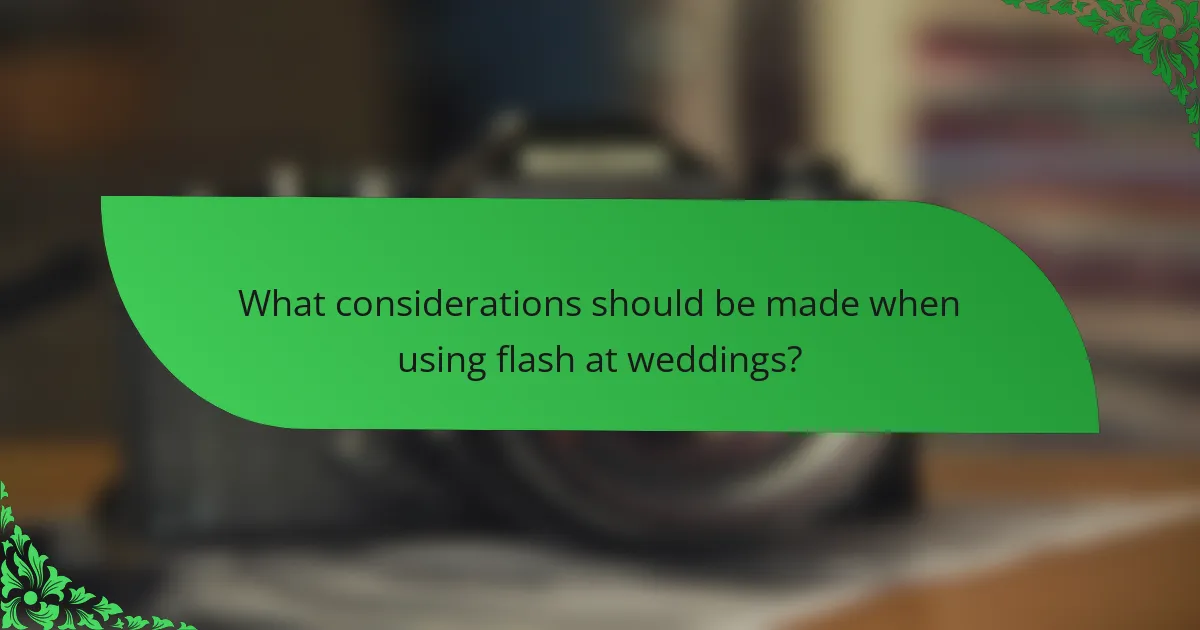
What considerations should be made when using flash at weddings?
When using flash at weddings, consider the lighting conditions and the venue’s ambiance. Assess whether the flash will enhance or disrupt the natural light present. Be mindful of the subjects’ reactions to flash; some may find it distracting or uncomfortable. Adjust the flash power to avoid overexposure, especially in dimly lit settings. Use diffusers or bounce techniques to soften the light and create flattering images. Ensure the flash sync speed matches the camera settings to prevent motion blur. Lastly, communicate with the couple about their preferences regarding flash usage during key moments.
How can you balance ambient light with flash?
To balance ambient light with flash, adjust flash output to match ambient light levels. Start by measuring the ambient light using a light meter or camera settings. Set your camera to the desired shutter speed and aperture for the ambient light. Then, adjust the flash power to fill in shadows without overpowering the ambient light. Use a lower flash power setting for softer light. Consider using flash diffusion to soften the light further. This technique helps create a more natural look. Use the camera’s exposure compensation feature to fine-tune the balance. Properly balancing ambient light and flash enhances the overall image quality.
What settings should be adjusted for optimal flash exposure?
Adjust the ISO, shutter speed, and aperture for optimal flash exposure. Increasing the ISO enhances sensitivity to light. Set the shutter speed to a value that syncs with the flash, typically 1/200s or slower. Adjust the aperture to control the amount of light entering the camera. A wider aperture allows more light, while a narrower one reduces it. These settings work together to achieve balanced exposure. Properly adjusting them ensures the subject is well-lit without overexposure or underexposure.
How do different lighting conditions impact flash usage?
Different lighting conditions significantly impact flash usage in photography. In bright daylight, flash can fill shadows and enhance subject details. In low-light situations, flash provides necessary illumination to avoid underexposed images. In mixed lighting, flash can help balance color temperatures between ambient light and the flash. Additionally, using flash in backlighting can create a rim light effect, highlighting the subject’s outline. Each of these scenarios requires adjustments to flash power and settings for optimal results. Properly managing flash usage in varying lighting enhances image quality and captures details effectively.
What are common mistakes to avoid when using flash in wedding photography?
Common mistakes to avoid when using flash in wedding photography include improper flash exposure settings. Photographers often set the flash too high, resulting in overexposed images. Conversely, underexposing can lead to dark photos. Another mistake is failing to diffuse the flash. Direct flash can create harsh shadows and unflattering skin tones. Not considering the background can also detract from the photo’s quality. A cluttered or distracting background can diminish the focus on the couple. Additionally, neglecting to adjust the flash for different environments can lead to inconsistent lighting. Photographers should adapt their settings based on indoor or outdoor conditions. Lastly, not practicing with the flash before the event can result in missed opportunities for great shots. Familiarity with the equipment is crucial for capturing memorable moments.
How can improper flash usage affect the final images?
Improper flash usage can lead to overexposed or underexposed images. Overexposure occurs when the flash is too strong for the scene. This results in loss of detail in bright areas. Underexposure happens when the flash fails to illuminate the subject adequately. This can cause shadows and dark spots in the image. Additionally, harsh shadows may appear when the flash is positioned incorrectly. These shadows can distract from the overall composition. Improper white balance settings can also lead to unnatural color tones. This affects the mood and aesthetic of the final images. Overall, incorrect flash usage can compromise image quality and viewer enjoyment.
What are the signs of overexposed or underexposed flash photos?
Overexposed flash photos appear excessively bright with loss of detail in highlights. Common signs include washed-out colors and a lack of contrast. Underexposed flash photos appear too dark with insufficient light on the subject. Signs of underexposure include shadowy areas and details lost in dark regions. Both issues result from incorrect flash power settings or improper camera exposure settings. Proper exposure is crucial for capturing clear and vibrant images.
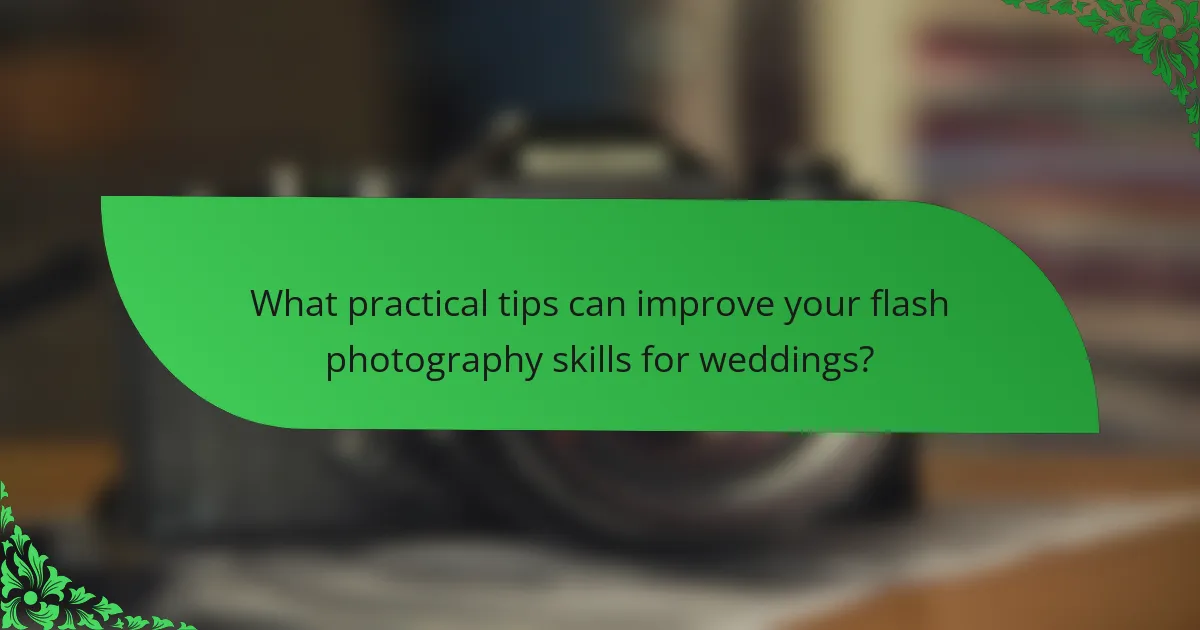
What practical tips can improve your flash photography skills for weddings?
To improve your flash photography skills for weddings, practice using off-camera flash. This technique allows for more creative lighting angles. Experiment with different flash power settings to achieve the desired exposure. Use a diffuser to soften the light and reduce harsh shadows. Adjust your camera settings to sync with the flash for optimal results. Familiarize yourself with the flash’s recycle time to avoid missed shots. Consider using multiple flashes for dynamic lighting effects. Lastly, practice in various lighting conditions to build confidence and adaptability.
How can practice enhance your flash technique?
Practice enhances your flash technique by increasing familiarity with settings and equipment. Regular use of flash allows photographers to understand exposure settings better. It helps in mastering the timing of the flash to capture perfect moments. Practicing in various lighting conditions builds adaptability. Repeated practice leads to improved reflexes in adjusting settings quickly. This skill is crucial during dynamic wedding environments. Studies show that consistent practice can lead to a 30% improvement in capturing well-lit images. Therefore, dedicated practice is essential for refining flash techniques.
What exercises can help you master flash usage?
Practicing with flash can enhance your skills in wedding photography. Start by experimenting with different flash modes. Use manual mode to control exposure settings. Practice bouncing flash off walls and ceilings for softer light. Try using flash in various lighting conditions, such as low light or bright sunlight. Set up a test shoot with friends or family to practice. Capture subjects at different distances to understand flash reach. Review your photos to assess the effectiveness of your flash usage. These exercises will build your confidence and proficiency with flash techniques.
How can reviewing past wedding photos improve your skills?
Reviewing past wedding photos enhances your photography skills by providing insights into composition and lighting. Analyzing these photos allows you to identify successful techniques and mistakes. You can observe how different flash settings affected the final image. This helps in understanding the timing and placement of your flash. Noting the emotional responses captured in those images can guide your future work. Additionally, comparing your earlier work to more recent photos shows your progress. This reflection fosters a deeper understanding of your artistic style. Ultimately, it leads to more informed decisions in future shoots.
What resources are available for learning more about flash in wedding photography?
Books on flash techniques are available for learning about flash in wedding photography. “Wedding Photography: The New Rules” by Pye Jirsa covers essential flash techniques. Online courses from platforms like Udemy and Skillshare offer structured learning. Websites like Fstoppers and PetaPixel feature articles and tutorials on flash usage. YouTube channels dedicated to photography provide visual demonstrations and tips. Forums like DPReview allow photographers to share experiences and advice on flash techniques. These resources collectively enhance understanding and application of flash in wedding photography.
Which online courses or workshops are recommended?
Recommended online courses for using flash in wedding photography include “Flash Photography for Beginners” on Udemy. This course covers essential techniques for mastering flash use. Another option is “The Art of Flash Photography” offered by CreativeLive. It focuses on advanced flash techniques and practical applications. Additionally, “Wedding Photography: Flash Techniques” on Skillshare is beneficial for learning specific wedding scenarios. These courses are well-reviewed and provide practical insights into flash photography.
What books or blogs provide valuable insights on flash techniques?
“Understanding Flash Photography” by Bryan Peterson offers comprehensive insights on flash techniques. This book details various flash methods and their applications. “Light, Science & Magic” by Fil Hunter, Steven Biver, and Paul Fuqua is another essential resource. It explores the fundamentals of lighting, including flash usage. The blog “Strobist” by David Hobby provides practical tips and tutorials on flash photography. It covers gear, techniques, and creative uses of flash. “The Digital Photography Book” by Scott Kelby also includes valuable sections on flash techniques. These resources are widely recognized for their practical and insightful content on flash photography.
The main entity of this article is flash photography in the context of wedding photography. The article provides an in-depth exploration of how flash can enhance wedding photographs by improving lighting, capturing motion, and reducing shadows. It outlines various types of flash, including on-camera and off-camera options, and discusses their specific advantages and applications. Key techniques for effective flash usage, including timing, bouncing, and diffusing light, are emphasized, along with common mistakes to avoid. Additionally, the article highlights the importance of practice and resources available for photographers looking to refine their flash skills in wedding settings.
